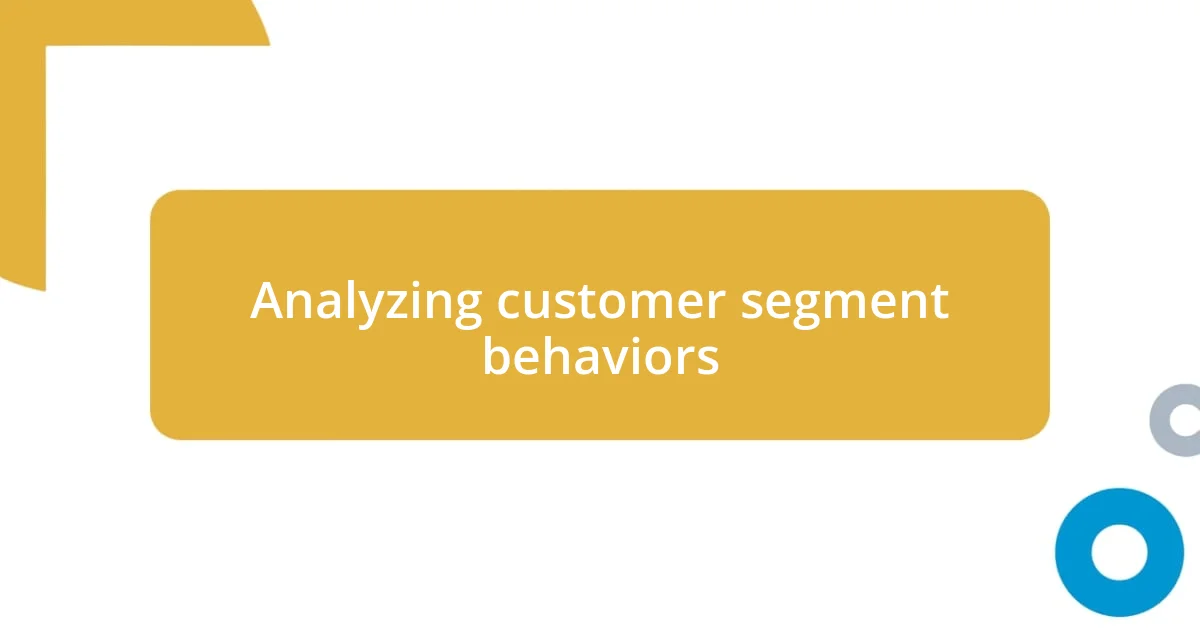Key takeaways:
- Market segmentation enables tailored marketing efforts, enhancing customer engagement and conversion rates by addressing the unique needs of distinct audience segments.
- Understanding and analyzing customer behaviors through various segmentation types—demographic, geographic, psychographic, and behavioral—can uncover innovative opportunities and refine marketing strategies.
- Measuring success through KPIs, customer feedback, and adapting to shifts in consumer behavior are crucial for the effective implementation of market segmentation, fostering lasting customer relationships.

Understanding market segmentation benefits
One of the most significant benefits I’ve discovered from market segmentation is the ability to tailor marketing efforts to specific audience needs. I remember launching a campaign aimed at young adults, only to realize that our messaging completely missed the mark with retirees. This experience highlighted how understanding distinct segments can dramatically enhance engagement and conversion rates—wouldn’t you agree?
Dividing a larger market into smaller segments allows businesses to focus their resources more efficiently. When I first began applying segmentation in my own strategies, I noticed a remarkable change in how customers responded. For instance, targeting a niche audience interested in eco-friendly products not only improved our brand loyalty but also established us as a thought leader in that space. Isn’t it fascinating how a tailored approach can foster deeper connections?
Another critical advantage of market segmentation is its role in enabling businesses to identify new opportunities for growth. By analyzing demographic data, I’ve often stumbled upon segments that were previously overlooked. For example, discovering a group of affluent millennials eager for premium experiences pushed my organization to create upscale offerings that resonated with their lifestyle. It just goes to show how understanding market nuances can lead to innovative ideas, doesn’t it?

Types of market segmentation models
Market segmentation models can be broadly categorized into four types: demographic, geographic, psychographic, and behavioral segmentation. I find demographic segmentation particularly invaluable, as it breaks the audience down into measurable characteristics such as age, gender, and income. For instance, I once targeted a campaign specifically towards new parents, and observing the shift in engagement was incredible; it felt like speaking a language they truly understood.
In contrast, geographic segmentation considers where potential customers live, ranging from regional trends to climate variations. During a recent project, I tailored our product offerings based on local tastes, which made such a meaningful difference. I remember the joy I felt when sales skyrocketed in a specific city simply because we adapted our marketing message to resonate with local flavors and trends, reinforcing how vital this model can be.
Then there’s psychographic segmentation, which dives into consumer lifestyles, interests, and values. I recall collaborating with a team focused on eco-conscious brands; we learned to connect emotionally through storytelling that highlighted sustainability. This approach not only refined our brand identity but also deepened customer loyalty—emotionally engaging consumers tends to be more effective than most traditional strategies, doesn’t it?
| Segmentation Type | Description |
|---|---|
| Demographic | Based on measurable characteristics like age, gender, income. |
| Geographic | Focuses on location, incorporating regional preferences and trends. |
| Psychographic | Concentrates on lifestyle, interests, and values of consumers. |
| Behavioral | Looks at consumer behavior, including purchasing habits and brand loyalty. |

Identifying target customer segments
Identifying target customer segments is a nuanced process that truly transforms how businesses engage with their audience. I remember the breakthrough moment when I dissected my customer database and found unexpected insights. For instance, a segment of tech-savvy seniors emerged—enthusiastic about smart home devices. Realizing this, we tailored content specifically for them, using language and imagery that resonated with their experiences. This not only increased engagement but also made me appreciate the richness of understanding diverse customer stories.
To identify these key target segments effectively, I often rely on the following strategies:
- Conduct Surveys: Direct feedback provides invaluable insights into customer preferences and behaviors.
- Analyze Sales Data: Examining purchasing patterns can reveal which demographics are most engaged.
- Monitor Social Media: Observing interactions can unearth emerging trends and preferences among various groups.
- Utilize Analytics Tools: Utilizing tools to segment website traffic helps in understanding the habits of different user groups.
- Engage in Focus Groups: Direct dialogue with customers offers qualitative insights that quantitative data may overlook.
By combining these methods, I’ve seen firsthand how diving deeper into customer data not only refines targeting efforts but also helps build lasting relationships.

Analyzing customer segment behaviors
To truly grasp customer segment behaviors, I often find myself diving deep into the data. I had a memorable experience analyzing online shopping patterns for a seasonal product. Originally, I was convinced that young adults would dominate the sales figures, but to my surprise, middle-aged customers showed remarkable loyalty during the holiday season. This revelation pushed me to rethink our marketing strategies, focusing more on retention efforts for that demographic.
Behavioral segmentation sheds light on how customers interact with brands, which I’ve found can be a game-changer. For instance, while analyzing a subscription service, I discovered that a small group of users consistently utilized the premium features. Curious about their experiences, I reached out to them. Their feedback was rich with insights about what kept them engaged and how they viewed value. This encounter reinforced my belief that understanding behavioral cues can unlock new ways to enhance customer satisfaction.
I often ask myself, “What if we could predict a customer’s next move based on their past behaviors?” Such reflections lead me to consider proactive strategies. Last year, we implemented a targeted email campaign based on customers’ browsing habits, and the uptick in engagement was phenomenal. It felt rewarding to connect with them just when they needed our products the most, highlighting how critical it is to analyze and respond to customer behaviors effectively.

Designing effective marketing strategies
Crafting effective marketing strategies hinges on truly understanding your target audience. When I first segmented my market, it felt like opening a treasure chest of opportunities. One particularly eye-opening moment was when I decided to develop personalized campaigns for each segment. I remember crafting a series of email newsletters tailored for parents juggling work and family life. Their emotional responses filled my inbox, and it amazed me how a simple tweak in messaging could create such deep connections. Have you ever thought about how a little personalization might change the game for your audience?
Once I recognized the distinct characteristics of my segments, the next step was aligning our offerings with their needs. For instance, while developing a product launch, I used customer feedback to shape the features that mattered most to them. I still recall the excitement I felt when a customer expressed that a particular feature we included was exactly what they had wished for. This reinforced my belief that effective strategies go beyond mere promotion—they connect on a deeper level by solving real problems.
Utilizing segmentation not only helps in crafting targeted campaigns but also enhances our overall brand messaging. I once had a conversation with a colleague about the importance of tone and voice. It surprised me to realize how various segments responded differently to our brand’s personality. Adjusting that voice to resonate with each group made a notable difference in engagement rates. Have you ever witnessed how the right tone can resonate profoundly with specific audiences? Recognizing these nuances can significantly elevate your marketing approach.

Measuring segmentation success
Measuring the success of market segmentation involves key performance indicators (KPIs) that can validate your efforts. I remember when we launched our segmented campaigns; one of the most effective metrics I tracked was customer retention rate. Seeing that increase month-over-month was exhilarating, reinforcing that we were not just reaching customers, but genuinely engaging them.
Conversion rates also serve as a powerful gauge of segmentation success. I’ll never forget the day I analyzed the results of a tailored campaign directed at young professionals. The numbers were astonishing—our conversion rate doubled compared to generic messaging! This taught me how precise targeting could transform indifferent prospects into enthusiastic customers, making me rethink how we approach every campaign.
Another aspect I consider is customer feedback and satisfaction scores. A memorable moment for me was receiving an unexpected wave of praise from our segmented audience after a recent initiative. Their comments highlighted how much they appreciated our understanding of their unique needs. This emotional response served as a reminder that true success in segmentation isn’t just about numbers; it’s about creating real connections that resonate with individuals. How do you measure those connections in your own marketing efforts?

Challenges in market segmentation implementation
Implementing effective market segmentation often comes with a fair share of challenges. For instance, I faced significant hurdles in gathering accurate data about each segment. Initially, I relied heavily on surveys, but I quickly learned that not every customer is willing to share their insights. I often wondered—how do you reach those elusive customers who hold the keys to your strategy? This led me to explore alternative data sources, like social media analytics. I discovered that mining conversations online was not only eye-opening but also a great way to understand actual customer feelings.
Another obstacle was the alignment of internal teams on segmentation strategies. I remember a time when our sales and marketing departments were divided on how to prioritize different segments. It was frustrating to see potential opportunities slip through the cracks due to miscommunication. I often think about how crucial it is to have a unified vision. Regular meetings to discuss each segment’s needs helped bridge those gaps, reminding me that teamwork can be just as important as data.
Additionally, the challenge of adaptability can’t be overstated. Once we had our segments identified, I had to be prepared for shifts in consumer behavior. I recall a seasonal campaign that flopped because we didn’t adjust our messaging to reflect changing trends. It was a wake-up call; how often do we miss the signal that our audience is evolving? Staying agile and responsive to these changes has become my new mantra, ensuring we remain relevant in an ever-changing marketplace.














